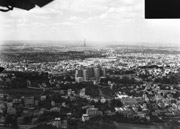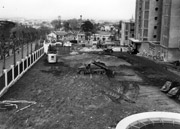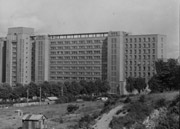In 1945, everything had to be rebuilt
After the war, the aeronautical industry and research in France were devastated. To bridge the technology gap between itself and the Allied Forces, the nation decided to rebuild French aerospace research.
In 1945, the Air Ministry constituted a “Conseil Supérieur Provisoire Scientifique de l'Air “("Air Scientific Provisional Supreme Council") composed of the most prominent French scientists and aerospace technology specialists: Prince Louis De Broglie, Engineer General Paul Dumanois, Nobel Prize Laureate in Chemistry Frédéric Joliot-Curie, Professor Joseph Pérès, Mining Engineer General Maurice Roy and the Chief of Staff of the Air Minister, René Jugeau.
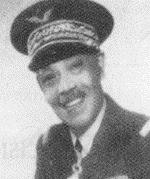 I.G.Suffrin-Hébert |
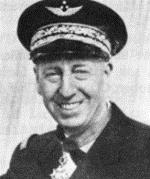 I.G. Bonte |
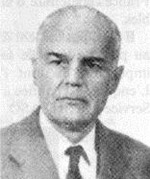 M. Benoît |
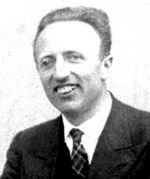 P. Rebuffet |
Air Military Engineers General, Champsaur, Poincaré (then director of the GRA) Suffrin-Hébert and Bonte must also be mentioned, as well as Mr Benoît, administrator of the GRA, Professor Teissier (director of the CNRS) and Mr Rebuffet (director of the Large Wind Tunnel in Chalais-Meudon, SRA). They participated in the discussions of the Provisional Supreme Council or its various working committees.
The mission of the Air Scientific Provisional Supreme Council is to reorganize aeronautical research. The accumulated delay could be bridged, provided that action was taken quickly, making real financial efforts to give France a modern aviation. The war enabled major technological revolutions to take place (jet propulsion in particular), which changed the situation and allowed access to new scientific and technical explorations. France therefore decided to gather all research resources owned or funded by the State within a public body.
1946, year of the foundation of ONERA
The five national aircraft manufacturing companies (SNCAN, SNCASO, SNCAC, SNECMA, SNCASE) created a subsidiary, SNERA (Société Nationale d'Ètudes et de Recherches Aéronautiques, national society for aeronautical studies and research), of which René Jugeau was the director from October 1st, 1945 to November 30th, 1946. A legal framework that enabled the creation of ONERA, whose birth was officially recorded on May 3rd, 1946, by a law passed unanimously by the Constituent National Assembly.
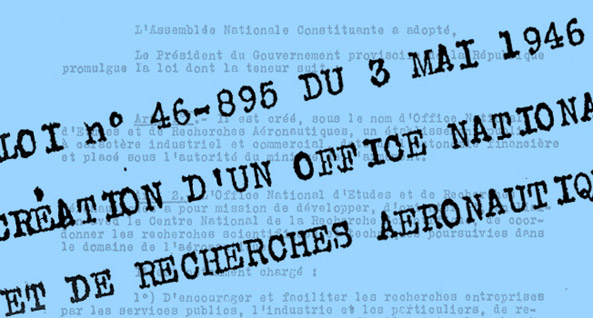
The principles of the creation of ONERA were clearly presented in the Law of 1946 through "the need to reorganize aeronautical research and to gather agencies that are currently working in a disperse way under a common scientific management, having research done by people who are prepared for it and that will build their careers in research, in an environment favorable for their development; this framework should be a flexible organization where researchers will not be locked into a rigid status."
Pursuant to the law, ONERA is a public establishment of an industrial and commercial nature, with legal personality, and is under the authority of the Department of the Air. Its status confers real management flexibility to it.
Article 2 of the law sets its mission, which is "to develop, guide and, in conjunction with the CNRS, coordinate scientific and technical research in the field of aeronautics ...". This mission was extended to space in 1961 (see http://www.onera.fr/en/french-aerospace-lab-en ).
On June 12th of that same year, a public administration regulation specified its mode of operation, defined the director's powers, the role of the board of directors and the scientific council, and the nature of its funding. The legal framework of the institution was thus established. All that remained was to embody it and set it in motion...
In September 1946, a large number of departments or institutions in charge of aeronautical research, scattered throughout France, were dissolved to be integrated to ONERA. Teams located in Paris, Neuilly, Chalais-Meudon, Palaiseau, Brétigny, Lille, Modane, Grenoble, Cannes, Toulouse and Alger-Maison-Blanche were concerned, in addition to various scientific detachments. At first, there were 230 people working in Aerodynamics, scattered throughout eleven workplaces, 230 people working in General Physics at nine workplaces, and approximately 265 people working in Energy & Propulsion and Materials & Structures in five workplaces.
Gradually, some were gathered at Châtillon in a building that had remained unfinished for ten years and which, around the years 1934/1935, was the subject of a scandal called the " Health Renaissance" (the Stavisky affair). It dominated the entire southern suburbs with its tall concrete structure and, above the 12th floor, the first arrivals discovered an edicule, already anachronistic, sitting on top of a spiral staircase, which was just a flat machine gun platform built by the Germans to control and defend the area! Visitors that able to admire the landscapes of Orly, Mont Valérien and Montmartre from the top of the showroom, never imagine what the early facility was like: the dust of the unfinished work, the cold bare cement, the hearth smoke stinging the eyes and the tar irritating the throat ... the actual consolidation of the staff was not really achieved until the investments made in Châtillon, Palaiseau and Modane had been completed. The daily work was already starting to bear fruit, as evidenced by the regular publication at that time of Recherche Aéronautique (Aeronautics Research), as well as ONERA’s Publications et Notes Techniques (Publications and Technical Notes.
Peu à peu, un certain regroupement se fait à Châtillon dans une bâtisse inachevée depuis dix ans et qui, vers les années 1934/1935, a fait l’objet du scandale dit de la « Renaissance Sanitaire » (affaire Stavisky). Elle domine toute la banlieue sud de sa haute carcasse de béton et, au-dessus du 12ème étage, les premières personnes arrivées découvrent un édicule, déjà anachronique, qui perché en haut d’un escalier en colimaçon, n’était qu’une plate-forme pour mitrailleuse, édifiée par les Allemands afin de contrôler et défendre le secteur ! Les visiteurs qui ont pu admirer, du haut de la salle d’exposition, les perspectives d’Orly, du Mont Valérien, de Montmartre, n’imaginent pas ce qu’était l’installation des premiers temps : la poussière des travaux inachevés, le froid du ciment nu, la fumée des poêles qui pique les yeux et celle du goudron qui irrite la gorge… Le regroupement des effectifs ne prendra vraiment fin qu’à l’achèvement des investissements engagés à Châtillon mais aussi à Palaiseau et à Modane. Le travail quotidien donne déjà ses fruits, comme en témoignent la publication régulière à cette époque de la Recherche Aéronautique, ainsi que les Publications et Notes Techniques de l’ONERA.
For more information, see:
French Aviation Articles of July 11th , 1945 :
La société nationale d’études et de recherches aéronautiques est née (The National Society for Aerospace Studies and Research is born)
La société nationale d’études et de recherches aéronautiques vient d’être créée (The National Society for Aerospace Studies and Research has just been created)
Ce que nous ont déclaré M. René Jugeau et l’Ingénieur général Suffrin-Hébert (What we have been told by Mr René Jugeau and Engineer General Suffrin-Hébert)
French Aviation Article of October 16th, 1946:
Le Conseil d’administration de l’ONERA est constitué (ONERA’s Board of Directors is constituted)
Minutes of the 1946 Board of Directors:
Board of Directors of October 10th , 1946
Board of Directors of October 19th , 1946
Board of Directors of November 23rd, 1946
Photo credits:
- ONERA for the biography of Mr Pierre
- Marc Rapin, DADS for excerpts from Aviation Française (French Aviation) 1945 and 1946
- ONERA, Wikipedia.
- Yves Aurenche, retired ONERA engineer.
References:
- Nouvelles de l'ONERA (ONERA News) No. 7, June 1966, notes and recollections of the founding of ONERA, by Jean Dubois
- 50 ans de recherches aéronautiques et spatiales (50 years of aerospace research), © ONERA - Paris, 1997.
- Histoire de l'Aviation pour les Nuls (History of Aviation for Dummies), Philippe Benhamou , First Editions, 2010.
- Comaero, un demi-siècle d'aéronautique en France (Comaero , half a century of aeronautics in France), Studies and Research (I) the CHEAr notebooks, Chapter 1, Pages 13-14
- wikipedia.fr
Références :
Les nouvelles de l'ONERA n° 7, juin 1966, notes et souvenirs sur la fondation de l'ONERA, par Jean Dubois
50 ans de recherches aéronautiques et spatiales, © ONERA - Paris, 1997.
L'histoire de l'aviation pour les nuls, Philippe Benhamou, First Editions, 2010.
Comaero, un demi-siècle d'aéronautique en France, Etudes et Recherches (I) Les cahiers du CHEAr, chapitre 1, pp.13-14
Wikipédia.fr



